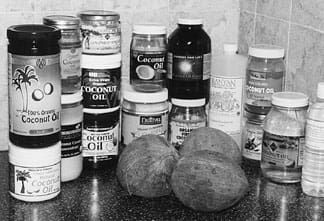Last month’s aromatherapy article (“Aromatherapy for Dogs“) introduced therapeutic shampoos, spritzes, and massage oils. If you and your dog tried any of the wonderful products recommended there, you may be ready to buy some essential oils and try your own custom blending for maximum effects.
Welcome to canine aromatherapy. According to Kristen Leigh Bell, author of Holistic Aromatherapy for Animals, “It’s hard to imagine a condition that can’t be prevented, treated, improved, or even cured with the help of essential oils.”
Bell mentions dozens of health problems that have resolved with the help of aromatherapy, from allergies to anxiety, bad breath to burns. It’s a fascinating branch of holistic medicine.
Essential oils, the foundation of aromatherapy, are the volatile substances of aromatic plants. They are collected, usually by steam distillation, from leaves, blossoms, fruit, stems, roots, or seeds. The water that accompanies an essential oil during distillation is called a hydrosol or flower water. Hydrosols contain trace amounts of essential oil and are themselves therapeutic. Other production methods include solvent extraction (a solvent removes essential oil from plant material and is then itself removed), expression (pressing citrus fruit), enfleurage (essential oils are absorbed by fat for use in creams), and gas extraction (room-temperature carbon dioxide or low-temperature tetrafluoroethane gas extracts the essential oil and is then removed). Each method has something to recommend it for a specific plant or type of plant.
However they are collected, essential oils are highly concentrated. To produce one pound of essential oil requires 50 pounds of eucalyptus, 150 pounds of lavender, 400 pounds of sage, or 2,000 pounds of rose petals. No wonder they’re expensive!
It’s not the fragrance that imparts the medicinal or active properties of aromatic essential oils but the chemicals they contain. Essential oils can contain antibacterial monoterpene alcohols or phenylpropanes, stimulating monoterpene hydrocarbons, calming esters or aldehydes, irritating phenols, stimulating ketones, anti-inflammatory sequiterpene alcohols, antiallergenic sesquiterpene hydrocarbons, and expectorant oxides.
Plants are complex chemical factories, and a single plant may contain several types of chemicals. In addition, each chemical category may have several different effects. Aromatherapy is a modern healing art, and the therapeutic quality of essential oils are still being discovered. In other words, aromatherapy is a complex subject that deserves careful study and expert guidance.
Start with Lavender
What essential oil should you start with? Everyone’s favorite is lavender, Lavandula angustifolia, a powerful disinfectant, deodorizer, and skin regenerator. It helps stop itching and has psychological benefits; it’s both calming and uplifting. Lavender is one of the few essential oils that can safely be used “neat” or undiluted, though dilution is recommended for most pet applications.
Here are a dozen things to do with a therapeutic-quality lavender essential oil:
1) Diffuse it in the room with an electric nebulizing diffuser (available from aromatherapy supply companies).
2) Add 10 to 20 drops to a small spray bottle of water and spritz it around the room. Be careful to avoid wood or plastic surfaces and your dog’s eyes.
3) Place a drop on your dog’s collar, scarf, or bedding.
4) Place two drops in your hand, rub your palms together, and gently run your hands through your dog’s coat.
5) Add 15 to 20 drops to 8 ounces (one cup) of unscented natural shampoo, or add a drop to shampoo as you bathe your dog.
6) Add two to five drops to a gallon of final rinse water and shake well before applying (avoid eye area).
7) Place a single drop on any insect or spider bite or sting to neutralize its venom (avoid eye area; dilute before applying near mucous membranes).
8) Add 12 to 15 drops to one tablespoon jojoba, hazelnut, or sweet almond oil for a calming massage blend.
9) Place a drop on a dog biscuit for fresher breath.
10) Add 15 to 20 drops to a half-cup of unrefined sea salt, mix well, and store in a tightly closed jar. To make a skin-soothing spray or rinse for cuts or abrasions, dilute one tablespoon of the salt in a half-cup of warm water.
11) Mix one teaspoon vegetable glycerine (available in health food stores) with one teaspoon vodka. Add 15 drops lavender essential oil, and add two ounces (four tablespoons) distilled or spring water to make a soothing first-aid wipe, ear cleaner, or wound rinse. Saturate a cotton pad, mist from a spray bottle, or apply directly to cuts or scrapes.
12) To remove fleas while conditioning your dog’s coat, wrap several layers of gauze or cheesecloth around a slicker or wire brush, leaving an inch or more of bristles uncovered. Soak the brush in a bowl of warm water to which you have added 10 to 12 drops of lavender essential oil, and brush the dog. Rinse and repeat frequently, removing hair, fleas, and eggs.
You can also blend lavender with other essential oils for a limitless variety of applications. Bell’s favorites for pet use are listed in the sidebar “Top 20 Essential Oils for Use With Pets.” “With these oils,” she says, “you can address a variety of common ailments: treat wounds; clean ears; stop itching; calm and soothe; deodorize; and repel fleas, ticks, and mosquitoes.”
Let Your Dog Pick an Essential Oil
Colorado aromatherapist Frances Fitzgerald Cleveland does more than consider which essential oils will work; she lets canine patients make the final selection.
“For any condition, there are several essential oils that would help,” says Cleveland. “For example, a dog who suddenly becomes afraid of loud noises and needs a calming oil would be helped by lavender, rose, violet leaf, basil, Roman chamomile, yarrow, or vetiver. But before giving her anything, let her smell each oil. I usually do this by offering the cap. If she runs to the other side of the room or turns her head away, that’s not the right oil to use. Don’t force it on her. Wait for her to find an oil she’s interested in, that she wants to smell more of. She may even try to lick the cap.”
Once you’ve found an essential oil that will treat the problem and that agrees with your dog, Cleveland suggests blending it with an easily digested vegetable oil, such as cold-pressed safflower oil. “Fill a five-millilter bottle (which holds about one teaspoon) with the vegetable oil and add three to five drops of the essential oil. Now put a few drops on your fingertips and offer your hand to her. She might lick it off your fingers. Then apply a couple of drops to her paws and to a bandana scarf tied around her neck.
“It’s fascinating to watch how these animals respond,” Cleveland continues. “I’ve seen it work with my own animals and with clients’ animals, and I’ve had an opportunity to work with orangutans and gorillas at the Denver Zoo. For all animals, but especially those who have been abused or who have never had an opportunity to make their own decisions in life, this approach is exciting because they get to choose, they get to say yes or no. Listening to what your dog has to say is important, plus it’s a great way to bond. You’re not doing anything threatening, you’re doing something helpful and healing, and the animals respond.”
Essential Oil Blending Secrets
Selection in hand, you can blend a massage oil, coat spray, or other product that your dog will readily accept.
Essential oils can be diluted in vegetable carrier oils, preferably organic and cold-pressed, such as apricot kernel, coconut, hazelnut, jojoba, olive, sesame, sweet almond, or sunflower oil. The general rule for canine use is to mix one teaspoon carrier oil with three to five drops essential oil or one tablespoon (½ ounce) carrier oil with 10 to 15 drops essential oil. Use standard measuring spoons, not tableware, to measure carrier oils; use an eyedropper or a bottle’s built-in dispenser to measure drops. There are about 20 drops in 1 milliliter (ml), 15 drops in ¼ teaspoon, and 60 drops in a teaspoon of most essential oils.
Essential oils can be mixed with water, but they will not dissolve. One way to dissolve essential oils in water is to add them to a small amount of grain alcohol, vodka, sulfated castor oil (also called Turkey red castor oil), vegetable glycerin, or any combination of these ingredients. Then add water, herb tea, aloe vera juice, hydrosol, or other liquid.
Because essential oils don’t dissolve in water, they can’t be rinsed away. If a drop of essential oil ever lands where it shouldn’t, such as in your eye – or worse, your dog’s eye – use a generous amount of carrier oil to remove it. Always keep vegetable oil and paper towels or soft cloths on hand for this type of emergency.
Also With This Article
“Top 20 Essential Oils for Dogs”
“Tea Tree Oil Diffusers Are Toxic to Dogs”
“Healing Oils For Your Dog”
-CJ Puotinen is author of The Encyclopedia of Natural Pet Care (Keats/McGraw-Hill) and Natural Remedies for Dogs and Cats (Gramercy/Random House). She wrote the foreword for Kristen Leigh Bell’s Holistic Aromatherapy for Animals.







There are 100 drops in a teaspoon (5ml) not 60 as stated in the article. That could have devastating effects as it would be almost double strength (60 vs 100).
20 drops per 1ml = 100 drops in a 5ml teaspoon (5x 20 = 100)
Thanks for the rest of the info though.